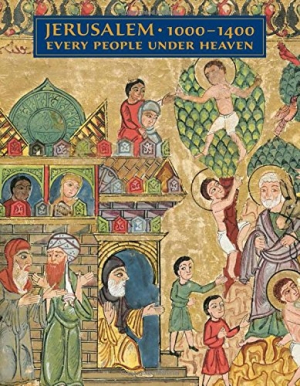Jerusalem, 1000-1400
Every People under Heaven
A celebratory spirit pervades the collection, which positions Jerusalem as a center of medieval hopes.
Against astounding contemporary arguments that Jerusalem does not represent shared the history of a bevy of religions and cultures stands the Met’s new catalog of medieval art, Jerusalem, 1000-1400. It features artifacts from the city itself, pieces that indicate great global longing toward Jerusalem, and items that speak to the curious and unique cultural milieu within its walls.
With attentiveness, Boehm, Holcomb, and contributing essayists draw out meaning from the featured pieces: a phylactery said to contain a bit of Jesus’s cross; a fragment from Salah ad-Din’s intricate Al-Aqsa midbar; sketches from Maimonides made upon his visit to the city.
Less overtly religious pieces play in, too, from glasswork almost a millennium old to scraps of once luxurious fabrics, now fraying toward oblivion. The essays that accompany these pieces champion the city—as a multicultural melting pot, where the suq bustled to meet the needs of pilgrims and travelers from distant lands; as a lightning rod for religious fervor; as a center of learning, development, and promise.
A celebratory spirit pervades the collection, which focuses far more on that which unites disparate people than it meditates on divides that were severe even then. It positions Jerusalem as a place upon which medieval hopes centered, and around which eternal imagination reached a gloried pitch. Karaite sects, Islamic architectural touches on the Church of the Holy Sepulchre, a storied arch—all become uniquely fascinating in this setting.
Such awe is reflected in the text’s particular emphasis on its topics. Travelers and tourists get multiple essays; religious warfare gets one, a brief, semi-sermonic interlude from James Carroll, recalling the perils of exclusivism that led up to the Crusades and sounding a warning against any return. Glossy photographs of mementos from our shared and hopeful past make Jerusalem a work sitting with—and worth returning to, whenever time is too short for a physical pilgrimage.
Reviewed by
Michelle Anne Schingler
Disclosure: This article is not an endorsement, but a review. The publisher of this book provided free copies of the book to have their book reviewed by a professional reviewer. No fee was paid by the publisher for this review. Foreword Reviews only recommends books that we love. Foreword Magazine, Inc. is disclosing this in accordance with the Federal Trade Commission’s 16 CFR, Part 255.

